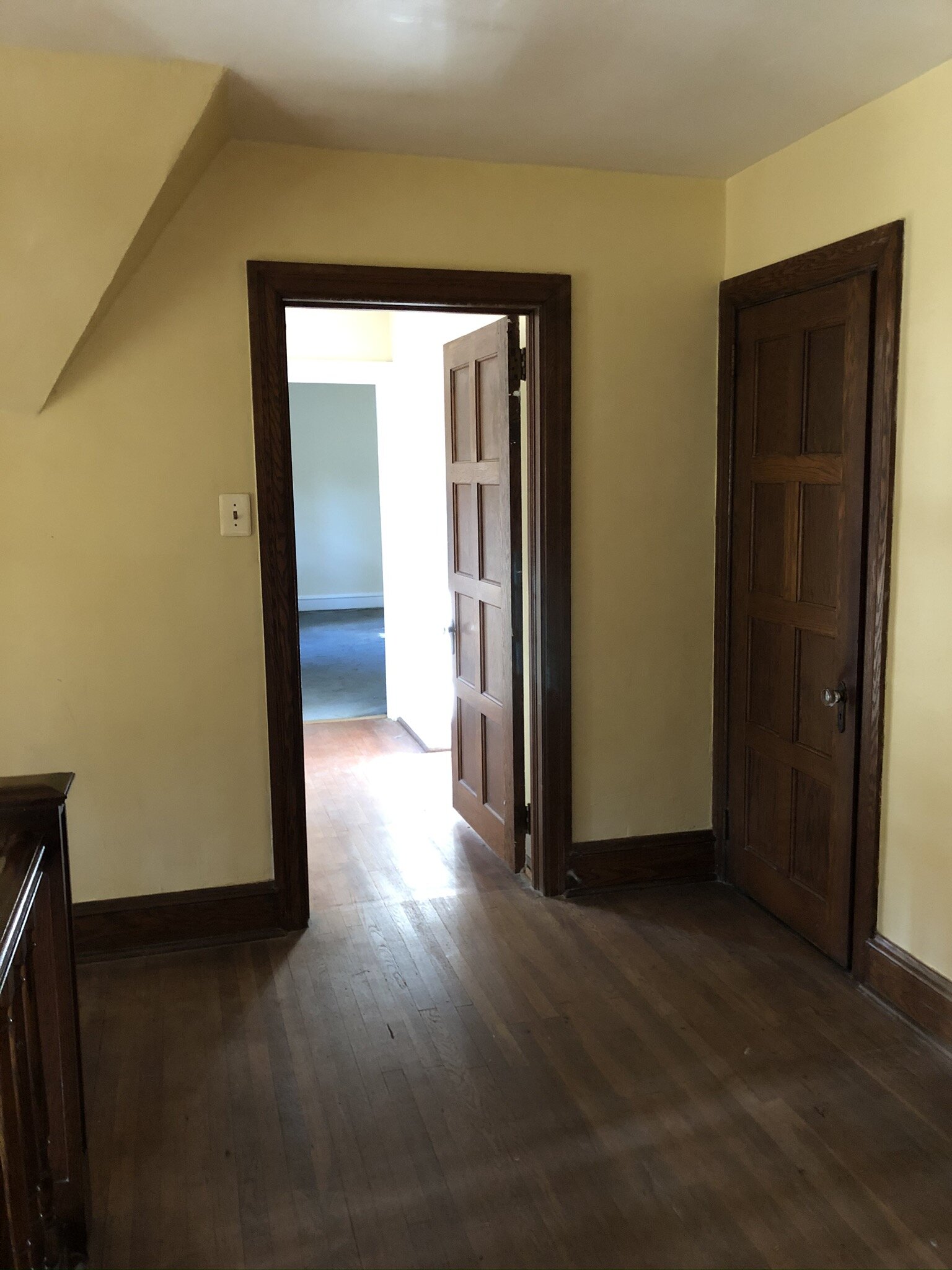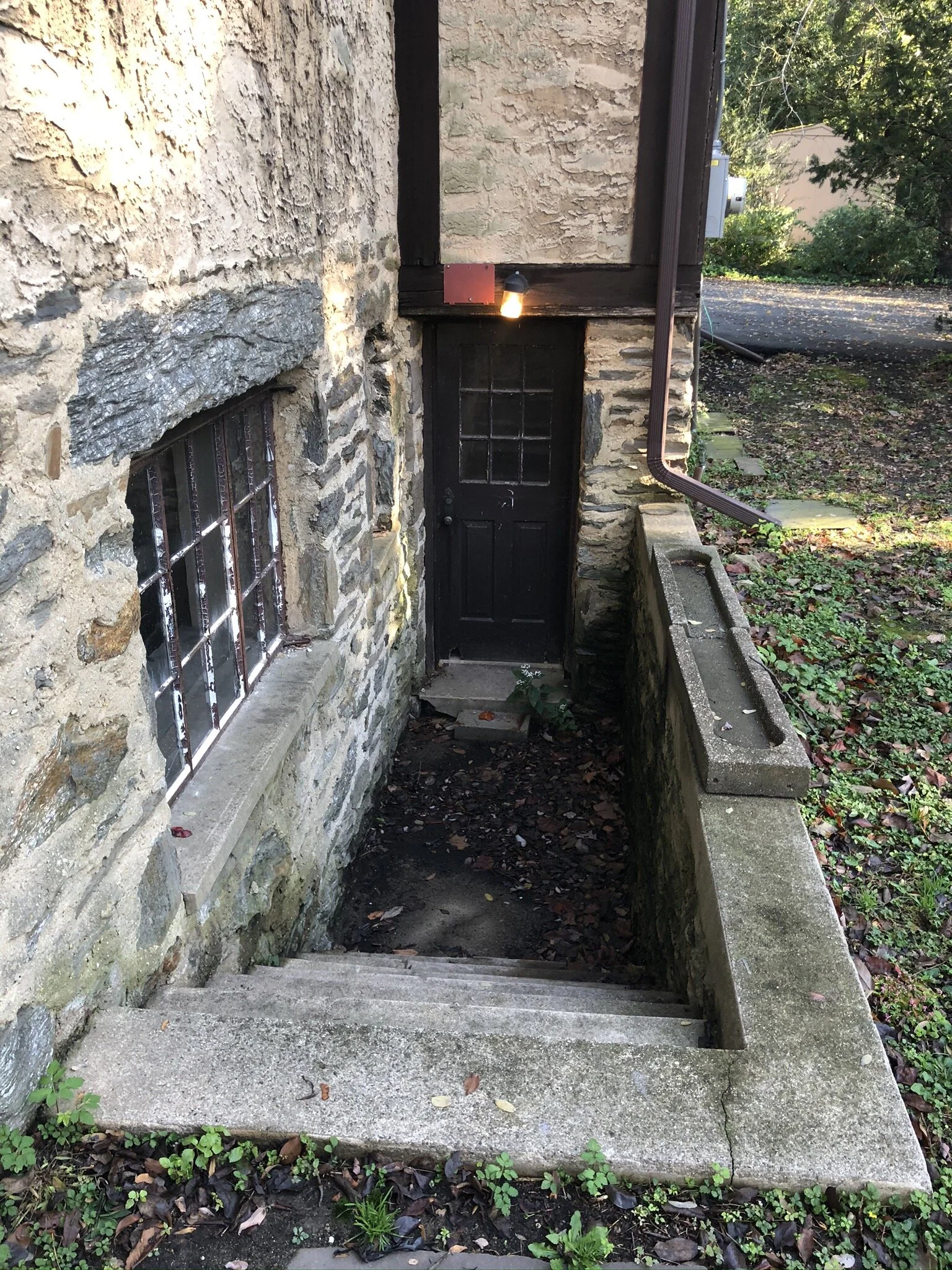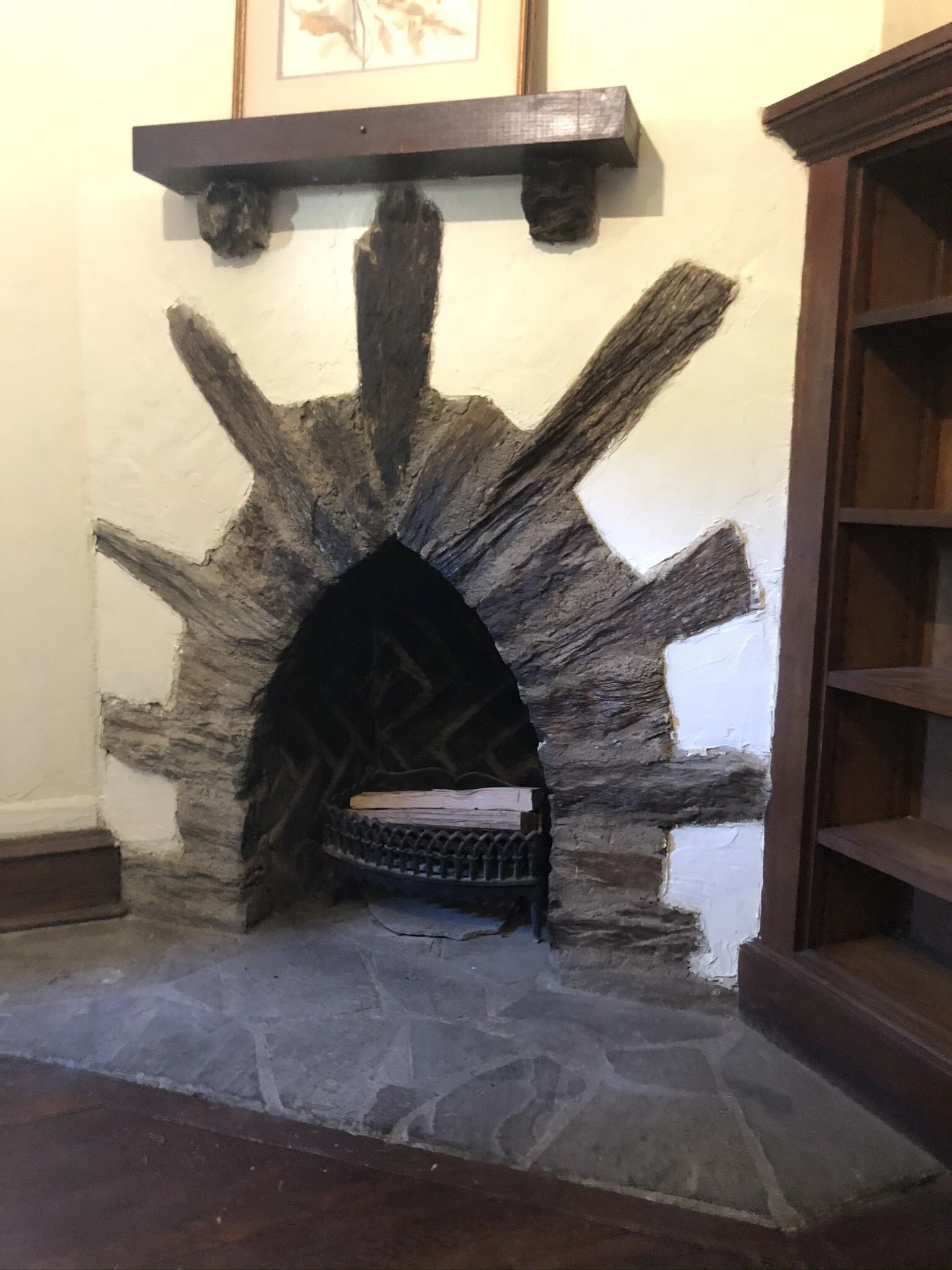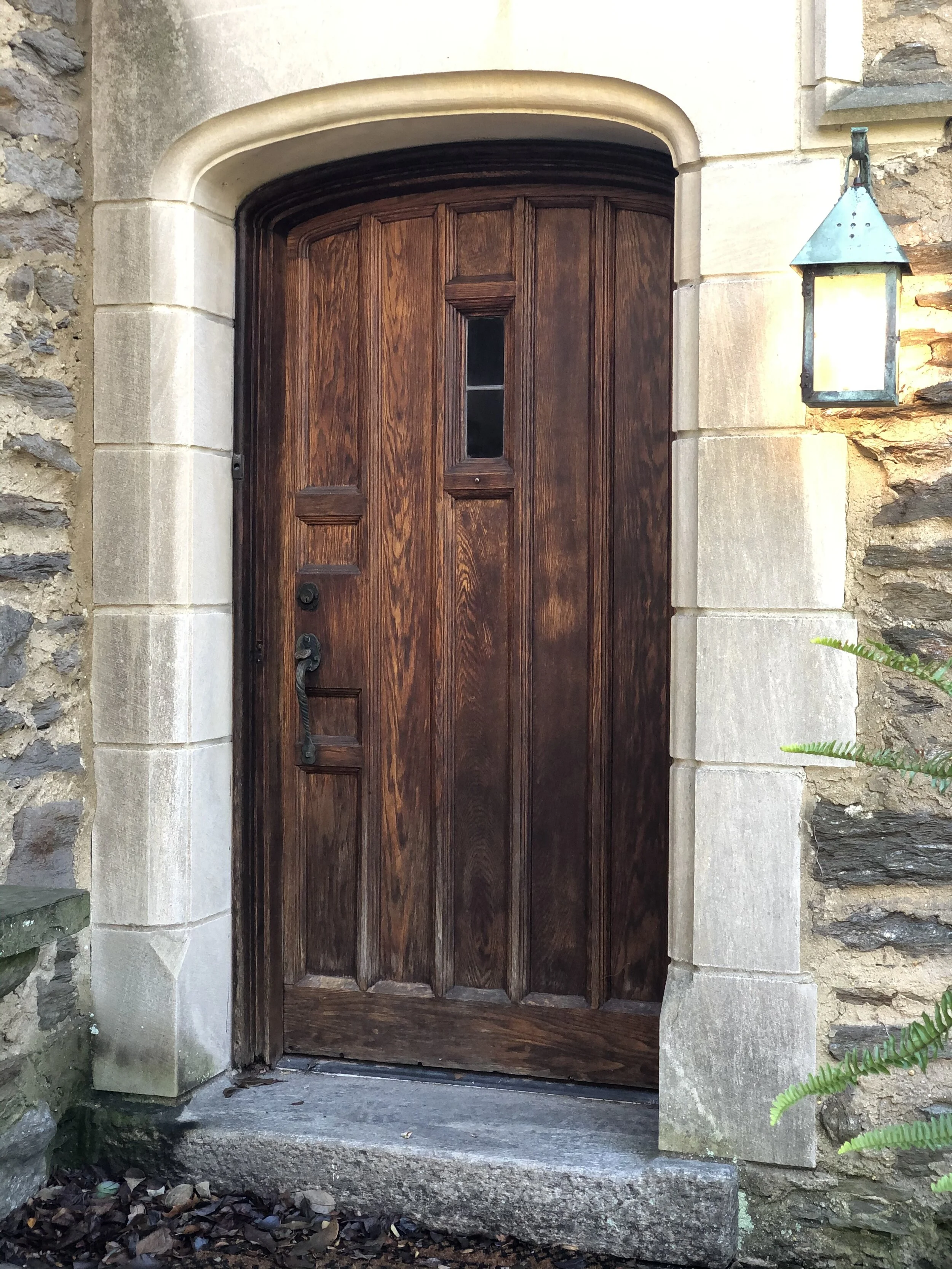Restoration vs. Renovation
Once upon a time….
….the selling agent who showed us our magnificent Tudor said to me, “look at all these gorgeous tiles, if you rip them out, I’ll know about it and know where you live”. And that statement haunts me to this day. I don’t think she meant it in a menacing way, and yet I feel terrified of her like a schoolchild worried they’re going to be sent to the headmaster’s office for a transgression. You see, we have three and a half bathrooms all complete with vintage square pastel-coloured tile of the variety that is common to see in US homes from the 30s/40s. What the selling agent didn’t mention (of course), but what was plainly visible, is just how unstable each bathroom is. Two of the four bathrooms have such large cracks in the cement floor foundations that they tangibly buckle when you step in certain spots. In all of them, the plumbing has been half-repaired with plastic crap over the years and cheap tradespeople have drilled through holes in the floor for convenience. Tiles are falling off of the walls, many are chipped, the walls are also cracked in multiple places. Rusty and sharp screws stick out all over the place as sanitaryware has been changed over the years. And then there’s quite simply the colours of the tiles themselves – canary yellow, mint green, cream/black and black. Two of those colours are ones my husband can’t stand – have a guess.
“Look at all these gorgeous tiles!!
If you rip them out, I’ll know about it
...and I know where you live!”
But the point of this post is not actually to discuss the bathroom specifics, but to talk about a topic that has weighed on me heavily since buying this house – the concepts of RESTORATION versus RENOVATION.
Someone asked me whether we were renovating or restoring our old Tudor home. Prior to this last year, I hadn’t really thought about the enormous strategic and financial dissonance between the two terms. Renovation typically means you’re removing what’s there and replacing it with something new… literally per the Latin base of the term “re” (again) “nova” (new). Whereas restoration details the painstaking, usually more time-consuming, and often more expensive method of repairing what already exists, extricating details as necessary, using old-trade methods to make it whole and placing it back. Again, quite literally the word in Latin “restauro” means to rebuild, and from its original Proto-Indo-European root means “to stand up again”. There are some very passionate people on both sides of the spectrum, and so I’ve spent a great deal of time noodling on the question and trying to figure out just what we are doing?
I’ve realised since owning our beautiful masterpiece of a Tudor, which is our second old home, that I harbour quite a lot of guilt on this topic. We owned a 110 year old farmhouse in Atlanta previously, but basically gutted everything except 2 rooms down to the studs and built a new house inside then added an extension. We transitioned it to an open floor concept for part of the home, we put in drywall, added new vinyl windows and followed a lot of design trends that were classic (::cough:: farmhouse ::cough::), but boring. See below for the before and after of the kitchen space. To look back on it now (although we loved the house we created at the time) makes me cringe to think of the history we removed. That said, we were also removing a lot of terrible 50s updates and half the roof was falling in, so there’s that too.
We have learned SO much in the last year though, delving into the old house community here, like we never did there. Instagram has been an incredible resource I didn’t know I had 3 years ago, and podcasts like “True Tales from Old Houses”, The Craftsman blog, The Old Town Home blog, the guys at My Tiny Estate and so many more have taught me that what I thought I knew about old houses a couple years ago was just the tip of the iceberg…
As such, and in my process of learning, I’ve decided on five key “restoration” principles in the last year which help us decide when to restore, and when to renovate. I’ll wrap up below these principles with our “house manifesto” which is a quick list of statements that help us navigate how we approach each project, as well as our ethos about the bathrooms in particular! ;)
1 // IGNORANCE IS BLISS
We honestly didn’t know any better. The Urban Farmhouse was our first old house renovation, and we had seen family members (even in the UK in listed centuries-old homes), renovate and extend their homes to make it work for them. To be fair to us, we had two separate architects and builder groups tell us to just knock down the whole house and rebuild completely, but we were absolutely adamant that the 110 year old structure not be removed… so at least we didn’t do that!! The structure of the house remained the same and we only re-enforced walls where they had been changed in the 50’s anyway. Although the house didn’t have a tonne of character to begin with, we did remove some original elements. I don’t think we’re different to any other home-owner on this front, and particularly, any other young-aged old-house owner…. The common thread I hear over and over again, is we’ve all done something wrong before, and we’re making up for it this time. You can’t know what you don’t know. At the least though, you can learn and grow.
2 // MODERATION IS KEY
There is a careful balance to strike when owning an old house that you can go so far down into the restoration tunnel, that you might end up feeling like you should eat your meals by candlelight, cook over an open flame in the inglenook, move the toilet outside and furnish it only with pieces you built without power tools. But modernisation continues to happen and technology, although it can be a bane sometimes, is a positive continuation of society. Changes in plumbing, electrical, structural engineering, waterproofing, etc are all elements that even the most die-hard of historical preservationists and old-house purists expect in their home these days. Plus cities now require most of these elements within planning permits for any upgrades, “grandfathering” only gets you so far.
What’s tricky is learning (slowly, very very slowly) which centuries old techniques are better quality but have given way to new products due to convenience, marketing, and a horrible cycle of obsolescence, and which centuries old products and techniques need to stay in history. For example, drywall is a fast, quick-churn product that suffers water solubility and longevity problems. But plaster is better quality, longer lasting, more breathable and sustainable, but takes much more intense labour preparation and application, so has slowly dissipated over the last 50 years. Whereas knob and tube wiring, although ground-breaking at the time, is now a dangerous electrical set-up that would inevitably lead to extensive fire damage. And this is where the learning process is perhaps a lot slower than one would like it to be, in terms of sticking to the ‘restoration’ guns. But the resources are out there now, it’s just a matter of how dedicated you want to be to learn which is better and how much you want to apply to your old house. We tend to apply safety and function in this principle more than anything else. Fire hazard? Out it goes. Lead pipes, nope. Adding in tiny, aesthetically pleasing spotlights to increase light within a dark home? Let’s do it. Figuring out re-plastering walls, sign me up. Moderation is key.
3 // ARE YOU A PURIST?
Secondary to the learning skills & products, is also figuring out how much of a “purist” you really are – i.e. is it important to you to retain or put back every inch of original features? Do you want to do the work yourself? Do you have time (and patience)? If you don’t have the time, do you have the funds to pay proper tradespeople? The reality is a lot of us buy old homes before really answering these questions fully and we figure it out as we go along. We know we don’t want a new build, we want character, but just how far are you willing to go? The answer, I’ve learned, is it depends… and more importantly, it changes over time.
For example, when we bought our house we were over the moon that the previous owner had replaced all 118 windows with new Anderson casement windows already. But in the year since learning more about window restoration and the marketing lies about new vinyl windows (thanks @blakehillhouse and @thecraftsmanblog)– I’ve realised that I kind of wished the house had its original windows still. The reality though, is we would likely not have bought it if it did – looking into the past is an easy thing.
As I peruse Instagram, I’ve often found myself saying “why did they buy the old house if they want to rip everything out, or paint it all” – but I also questions myself with the same statement frequently and the reality is our purism levels are just different, or in the process of changing. I personally can’t bear to paint original woodwork or build in super modern furniture; I think it’s a crime. But does it destroy value if it brings joy to the owner to do so? Ultimately, no. You just need to figure out where you will draw your line on preservation purism. For example, we will be re-mortaring the basement stones ourselves (probably a year long project by itself) and restoring the steel windows down there, but we will also be adding a modern moisture barrier to make it a space we can actually finish. At 1200+ sq ft, we are wasting extensive real estate to not do the modernisation aspect.
4 // HISTORY IS REPEATABLE NOW.
And I don’t mean in the awful history book sense of politics repeating themselves, but in the more positive design and availability terms. This one’s taken me a while to nail down, but it helped us form an important backbone of our ‘manifesto’. 20 or 30 years ago, the availability and accessibility of reproduction or hand-made products that would have been found in turn of the century houses was nearly impossible. If a manufacturer of said product was in California and you were in Pennsylvania… or vice versa… you were unlikely to be able to source it.
But the internet has changed everything. Salvage yards can list products on their Instagram pages to sell across the continent, tile manufacturers selling square pastel coloured crackle glaze ceramics and coloured hexagon oenny tile can now ship to anywhere in the world, woodworkers can share their techniques for mortise & tenon joints, and learning about proper architectural design is only an e-book, quality YouTube video, or good Instagram page away. It matters!! I fully believe in the ethos of preserving materials, processes, and artifacts that won’t ever be produced in the same way again (for example, we’ll never touch the doors in our house except to restore them) but you have to do it all with a modicum of sense as well as respect.
That said, being able to recreate historical features is now 100% feasible, as long as you are able to recognize the period of your home and understand what is appropriate to it. Woodworking and masonry (our stones) is the one exception where we refuse to replace anything – you simply can’t get the same quality pieces or craftsmanship these days, you will always be able to tell it’s new. For example, here is a “vintage” bathroom that was just built, and a panelled drawing room that was also just built, even using traditional methods. The bathroom you couldn’t tell that it wasn’t 100 years old… the drawing room still looks modern.
5 // OLD IS RELATIVE & YOU DONT LIVE IN A MUSEUM
Stu likes to say “just because it’s old, doesn’t mean it’s valuable”, and while I hate him for it sometimes, it’s true. Furniture is meant to be used, houses are meant to be lived in and provide happiness, as well as a roof over your head. We’ve struggled with this concept a bit as well due to American versus English differences.
In the UK, you don’t find many people taking others to task about using plasterboard instead of proper plaster, people don’t become pedantic about fitting a new kitchen or toilet, and plenty are still considerd “restoring” old properties. We realised it may be because of the sheer level of history. In the UK, old houses are the norm, not the oddity. There is so much history that you don’t have to be as precious about revising it. 100 years isn’t old there… 400 is, and those houses are conservationally listed to ensure they are maintained. Plus, because old is normal, quality tradespeople and historical products are readily (and affordably) still available.
But in the states… 100 is very old, and quite rare, especially outside of the Northeast. So preservation in this country gets a bit more wrapped up in emotions, especially as the same protections are not put in place, and the small preservation community wants to maintain the minimal amount of history that there is. My point in mentioning this, is that in the UK, removing old tile isn’t seen as sacrilege – there’s not an expectation to live in a museum for the sake of preserving history. The culture is that you make your house work for your family. No, we shouldn’t demolish old buildings, but changing the inside is ok, as long as you do it sympathetically. And while preserving history in the US is important, per the other principles, there are still limits.
OUR HOUSE MANIFESTO:
- Honour & respect the house’s past.
- Function is important: Repair whenever possible. Modernise when necessary.
- But modernise sympathetically.
- Don’t touch the wood, unless you’re stripping it of paint or it’s rotting.
- If you can replace it identically, it is ok to remove.
- Find the Tudor merriment.
And to bring this whole novel to a conclusion… what about our bathrooms? Here’s a summary of all of the above principles put into one specific example. Will we be removing the vintage tile from our main bathroom? Yes. Now, we may get raked over the coals by some in the old house community for this, but here is the rationale…
A Tudor Revival is already a reproduction of the original.. and I come from the country where the original exists. But real Tudors didn’t even have bloody bathrooms… just bedpans and jugs of hot water, and we’re not trying to maintain that, are we?! Being an interior designer by hobby, I would much rather put a more historical feeling Victorian style bathroom in our Tudor house than maintain a tile from 90 years ago that neither speaks to us, nor feels architecturally accurate in my opinion. Yes, it’s ‘original’ tile – but those tiles are easily produced and purchased today, and if we’re going to upgrade the bathroom to new plumbing features for water safety (i.e. removing lead pipes, and therefore having to remove all the tile), then we may as well change out the tile to a colour we like as well and make the layout more productive too.
We have so many real Tudor features in our home, but the bathrooms just aren’t. And we’re trying to actually add back in more features that would be true(r) to an original Tudor, not a revival, given that’s how our house feels on the exterior and in other rooms like the parlour and boot/keeping room. Perhaps that makes me a historical snob and a renovationist, versus a preservation purist, but that’s my take. Our bathrooms will feature bullnose, baseboard tile, crackle glaze subway tile (hand-made), curves and clawfoot tubs a la the Victorian era, i.e. the first historical era to have sanitary bathrooms. Oh, and the floors won’t buckle under us. If someone down the line wants to put a “vintage” 30s style bathroom back, then they are welcome because that is 100% possible these days, and alleviates our concern about removing it. We will salvage what we can and donate to restoration communities and those who do want to maintain or restore their pastel-hued mausoleums. Ultimately, we want to do the house justice, but we don’t live in a museum and never will.
….And we will still live happily ever after!






















